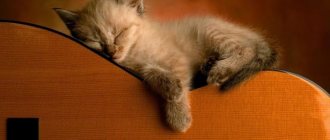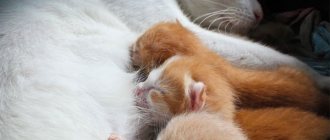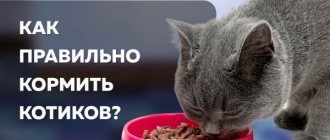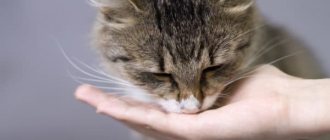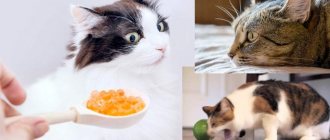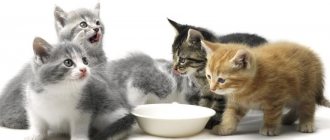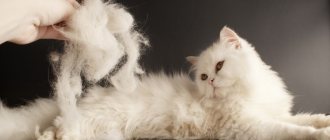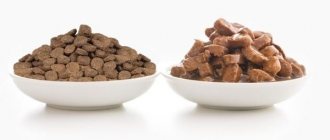Is it possible to feed a neutered cat fish?
There is an assumption that after castration, the likelihood of developing urolithiasis may increase. Therefore, most veterinarians, after surgical intervention, advise owners to completely exclude fish products from the menu of a castrated cat in order to prevent the development of serious pathology.
Still, many experts believe that it is permissible to eat fish, but very infrequently, once every 14 days, boiled and in small quantities. However, it is worth observing the following requirements: low-calorie products, always boiled and not raw meat, and also the absence of extra pounds. at the pet's.
Pixabay.com
Symptoms of diseases caused by a fish diet
The root cause of all cat diseases after castration is improper nutrition with excess calories and protein. Determining whether a cat is overweight is simple:
- when stroking, you cannot feel the ribs and spine;
- there is no “waist” between the sternum and hips;
- hanging belly with folds.
Urolithiasis - the formation of sand, stones in the kidneys, bladder has the following symptoms:
- frequent or prolonged urination;
- pink urine;
- painful meowing;
- excessive cleanliness under the tail.
Every fourth cat suffers from urolithiasis; the percentage of cats with urolithiasis due to castration is even higher.
© shutterstock
Initial signs of hyperthyroidism:
- hyperactivity;
- sloppiness;
- increased appetite;
- weight loss;
- cardiopalmus.
Often this disease affects cats after castration over 7 years of age. The cause of its occurrence is not only raw or boiled fish, but also canned fish from iron cans.
Is it possible to feed a sterilized cat fish?
Why can't cats eat fish? Sterilization implies many restrictions on the cat’s diet, and especially on fish products. The absorption of elements slows down, and there is a tendency to become overweight. Because of this, veterinarians recommend excluding fish from the menu of a sterilized pet.
For such cats, it is possible to prepare porridge, purees, and soups in fish broth. It is allowed to supplement the menu with vegetables and herbs.
Pixabay.com
Owners' opinions
Owners' opinions on the need to include fish in a pet's diet are very contradictory. Many believe that a natural product is better than any canned food, while others responsibly follow the recommendations of experts and exclude fish from the animal’s daily menu.
Let's look at a few arguments coming from supporters of “fish in a cat's diet” and find out what contradictions there are to their statements. All village and street cats eat fish and have no health problems!
What kind of fish can you give your cat?
A large number of breeders are interested in the question: is it possible to feed a cat fish and how much to give? Your pet should eat fish once every 7 days. However, these must be different varieties. When selecting products for a cat’s diet, you need to take into account the age and well-being of the animal, and what it eats best. Pets are allowed to feed sea and river fish, although the choice falls on one option.
Names of fish that are best to feed cats:
- pollock;
- hake;
- cod;
- salmon;
- trout.
When selecting, it is necessary to take into account the type of product on the pet’s menu, such an indicator as the animal’s obesity. If he is rapidly gaining extra pounds, then it is unacceptable to give him fatty fish options, such as sardines, mackerel, and herring. For large pets, low-fat varieties are better - hake, pollock or cod. These dietary seafood are low in fat, but also low in vitamins A and D.
If a cat expecting offspring eats a white product, then this can become the basis for a deficiency of vitamins in the body. It is advisable to give pregnant fluffies less often, about once every 14 days, red fish, due to the higher content of nutritional omega acids and vitamin components. Many owners completely exclude all types of seafood from the cat menu if they are planning to become mothers, believing that these products are harmful during the period of gestation of kittens.
Healthy foods
Half of the diet is made up of proteins, the rest is made up of carbohydrates with fiber and fats.
It includes the following “dishes”:
Poultry, rabbit, beef. This is the basis of nutrition, it is given daily in boiled form, raw food is pre-frozen for 5 - 6 days. Before feeding, cut into pieces. Minced meat is allowed if you prepare it yourself; store-bought stuffing is too fatty. Fresh meat is not fed to avoid infection with helminths.
By-products: lung, kidneys, liver. They contain nutrients that are not found in muscle fibers; they are also frozen or boiled and included in the diet 2 times a week.
Meat broths. It is useful to accustom sterilized pets to this dish: they need an increased amount of liquid, but they are reluctant to drink water.
Vegetables: zucchini, carrots, pumpkin, cabbage. The boiled product is crushed into puree, the raw product is grated. If the pet refuses vegetables in their pure form, they are mixed with chopped meat or broth.
Fermented milk products up to 10% fat. Ryazhenka, sour cream, kefir, yogurt without fillers, and cheese are suitable.
Porridge: rice, barley, wheat, buckwheat. A teaspoon is added to meat or offal. If the animal refuses, then it is replaced with bran.
Vegetable oil, butter. Add 2-5 drops to food to maintain normal coat condition and improve stomach function.
It is useful to sprout greens from wheat grains, oats, or buy ready-made grass at a pet store. Vitamin and mineral supplements are given only on the recommendation of a veterinarian.
Benefits and harms
So, is it still possible to pamper your pet with treats made from red and white fish, or is there no point in taking such risks? To understand this issue, you need to familiarize yourself with the beneficial and harmful properties of such a product.
Among the main beneficial qualities of fish are:
- contains easily digestible protein in the structure;
- high% of vitamins A and B;
- there is a large amount of phosphorus and magnesium in the structure;
- fatty fish can act as a source of Omega-3 acid.
However, fish has many more harmful properties:
- Causing damage to the kidneys. The high percentage of salt contained in the structure of the product negatively affects the functioning of this organ. Often, pets who are given fish suffer from urolithiasis, since the presence of phosphorus and magnesium in the structure contributes to the appearance of urinary stones.
- Increased risk of developing helminthiasis. Against this background, damage occurs to the liver, gallbladder and pancreas. Often, helminthic infestation is provoked by an incorrect cat menu. It is unacceptable to feed a purring pet raw fish that was caught in the river.
- The development of hypovitaminosis, which appears against the background of the presence in the structure of many types of product, the enzyme thiaminase, which destroys B vitamins. Subsequently, the animal begins to suffer from anemia.
- A decrease in the content of vitamin E in the body, which occurs against the background of regular addition of this product to the cat’s menu.
- A significant number of bones, which is often used as a motive to injure the throat and stomach area of the pet.
Why can't these animals fish? One of the reasons is the content of destructive thiaminase in the structure of many varieties of fish. It promotes the destruction of vitamin B. To destroy the dangerous substance, you need to cook the fish for at least 10 minutes.
Pixabay.com
Dry cat food
If a novice breeder does not have enough time or knowledge to keep a pet on a natural diet, you can feed it with ready-made food. Their use greatly simplifies the procedure of feeding a pet; however, there are rules that must be followed so as not to harm the cat’s well-being.
It is strictly not recommended to give animals cheap food that is sold in every grocery store. They are made from low-quality ingredients and contain dyes and flavoring additives that are detrimental to the animal’s well-being (prolonged consumption of such feeds provokes the development of urolithiasis). Also, additives in cheap food provoke addiction, and in the future it will be difficult to switch your furry friend to normal nutritious food.
You need to purchase professional food. Their price is significantly higher, but it is completely justified. This food has a balanced structure, is made from high-quality products (usually meat and cereals), and has no dyes or flavoring additives. A large assortment of products makes it possible to choose food depending on the age category, what they like best, breed, and state of health of the animal.
Pixabay.com
Wet food and canned food
These foods are excellent for kittens and older cats.
An alternative to dry food is moistened food and canned food. They contain all the elements required for pets and have a balanced structure, are also easier to chew and are suitable for kittens, older cats and pets with a sensitive digestive system. Canned food is produced in single-use packages and cans, their humidity reaches 85%, so cats drink less water when fed wet food.
The disadvantages of wet food include a shorter shelf life than dry food and the need to store open packaging in the refrigerator. When purchasing such food, you should carefully inspect the packaging - it should not have any swelling, damage, or traces of rust; the expiration date of the food should also be checked.
Freepik.com
Is it possible to give a cat smoked, salted fish or river fish with bones?
Experts strongly recommend against feeding your pets smoked and salted products. Smoked meat is quite difficult for a furry pet and has a negative effect on the liver. Subsequently, the manufacture of such a product creates carcinogens that negatively affect the gastrointestinal tract and provoke the development of tumors. Salted fish contains a large amount of salt, which is contraindicated for pets. Excess salt may cause cramps, diarrhea, excessive urination, lethargy and increased thirst. The animal can die within 24 hours.
Fish with bones from fresh water should not be fed to pets. The bones themselves become the cause of most diseases and visits to the veterinarian:
- the bones can harm the throat when the animal begins to chew fish fillets;
- sharpened fragments can scratch the stomach when passing through it and are a cause of injury and bleeding;
- In the gastrointestinal tract of a cat, pointed bones provoke an inflammatory process or sepsis.
It is possible to remove a fish bone from a pet's body only under general anesthesia, however, an x-ray will need to be taken in advance.
Before feeding your pet fish, be sure to cut off the fins and gills. They can damage the pet’s internal organs - injure the walls, and thus cause bleeding and digestive disorders.
Pixabay.com
How to stop a cat from eating fish
It is necessary to replace fish protein with meat protein. But what should cat breeders do, who, due to their inexperience, always gave them fish, and now they refuse other food? Could this mean that there is no need to change anything, and let this product remain in the diet? Definitely not. It is necessary to wean the animal off it, but this should not be done immediately, so as not to cause mental trauma to the purring pussy. It is necessary to understand that it is very difficult to overcome an addiction to fish, but by correctly replacing fish protein with meat protein, you can quickly achieve results, and you will not need to endanger the well-being of your furry friend.
By the way, by choosing boiled fish on your pet’s menu, if he really loves this seafood, you can give him ready-made fish-flavored food. It turns out that for ready-made complementary foods, the products undergo special processing cycles, and for taste and aroma they are supplemented with completely safe fish meal, in optimal quantities. And, Omega-3 and Omega-6 fatty acids from the fish structure can be easily replaced with additional vitamin components and supplements.
Taking into account all these suggestions, you can ensure that the fish on your pet’s menu will be a treat for him to enjoy, and not food that could threaten his life and health.
Did you like the recipe?
What is sterilization?
Let's understand the terminology: sterilization and castration. Many people believe that cats are castrated and cats are sterilized, but this is not true.
Castration is the removal of reproductive organs: in cats the uterus and ovaries, in cats the testicles.
Sterilization is another procedure in which a cat's fallopian tubes are tied, and males' spermatic ducts are ligated.
After sterilization, the animal continues to “walk”, mark, and in the case of a cat, ask for a cat.
If you care about your health. After such an operation, the cat will not suffer from hormonal imbalances. However, for some reason, the term “castration” scares owners, especially men. The widespread use of the term “sterilization” is nothing more than an attempt to avoid the wrong reaction of inexperienced owners.
When a cat reaches sexual maturity, the owners experience round-the-clock meowing, eyes full of sadness, rolling on the floor, walking with their butt up, and so on for 10–14 days. Sleepless nights, complaints from neighbors, a generously marked front door, if street cats have access to the entrance... stop! All these are your problems that you feel and see, but what happens to the animal? Something like this:
- In the first days of estrus, the cat will experience constant mood swings and nagging pain in the abdominal cavity.
- Further, the pain intensifies, the cat begins to roll on the floor. Some owners observe the cat's behavior with interest, believing that she likes it. Often this opinion is reinforced because the cat purrs. In fact, all these manipulations are undertaken by the cat to stop or dull the pain from spasms.
- The peak of estrus, intended for fertilization, passes, and is replaced by a hormonal imbalance - the system did not work as it should, all the hormones that prepare the cat’s body for motherhood are not needed and the body is forced to cope with this situation.
Have you read it, been horrified, and are already going for miracle pills like “Stop Heat”? Take your time, read on. So, the owner looks at the animal’s suffering and chooses one of four options:
- Submit to nature , breed a non-pedigreed (without pedigree) cat and acquire a new problem - kittens that no one wants. Statistically, even if you manage to place a new offspring, 70% of your graduates will suffer a very difficult fate. Simply put, they will join the ranks of homeless animals. Another point - one mating, one birth, one feeding - this is a wild overload of the body and a solution to the problem with estrus for a year at best (some cats can give birth 2 times a year). It's worth it?
- Tolerate the screams and wait for the cat to take a walk - of course, during the first heat, this is what you need to do in order to sterilize the cat later. If you decide for yourself and for the cat that you will endure it all its life, the pet is guaranteed to develop health problems, and its lifespan will be reduced by about 3 years. By the way, it is better to carry out the operation before the first heat.
- Giving pills is the most thoughtless and harmful decision an inexperienced owner can make. It is known that even after one dose of such drugs, cats can develop pathologies of the uterus and ovaries. Regular use of medicinal contraceptives leads to the development of chronic diseases of the reproductive system and oncology.
- Sterilize the cat.
The choice is yours! If your cat lives in the house as a companion and a member of the family, you do not plan to go to exhibitions and devote your life to the development of a certain breed - the reasonable choice is obvious.
It was already mentioned above that it is better to sterilize a cat before the onset of the first heat or 2-3 weeks after it (sometimes it is very difficult to predict the timing of the onset of heat). The operation should be performed only by a trusted doctor with a good reputation. The procedure is performed under anesthesia. An incision up to 2 cm long is made on the cat's side or along the linea alba (on the stomach). The incision site is preliminarily injected with local anesthesia and adrenaline (to reduce blood loss). Next, the uterus and ovaries are removed from the abdominal cavity, clamps are applied, and cutting is performed. If the operation is performed with a cautery, the incision site is immediately cauterized; using a scalpel, the surgeon (if necessary) stops the bleeding.
After removing the uterus and ovaries, three sutures are applied: deep, muscular and external. The incision site is treated with antiseptics, and a blanket is put on the cat. The procedure takes from 30 minutes to 2 hours, depending on the technique and instruments used.
After surgery, the cat quickly recovers from anesthesia, but remains lethargic for 18–24 hours. The pet will sleep a lot, your task is to make sure that it does not freeze (especially in winter), has access to water and does not show excessive activity. In the first days after sterilization, it is recommended to feed the cat only soft and liquid foods so that the pet does not have to strain the peritoneum during defecation. If the operation was performed efficiently, the suture will scar after 2–3 days. Sometimes the seam gets wet and ichor accumulates under the skin, but these problems are easily solved.
Important! After sterilization, the cat must wear a blanket or Elizabethan collar. The seam should remain dry and the cat should not lick it. When wearing a blanket, no additional dressings are required!
If the external suture is not applied with a self-absorbing thread, it is removed after 7–10 days. Many veterinarians insist on a course of antibiotics (3-5 days) after surgery. By and large, this measure is fair, but do not forget that antibiotics kill all bacteria, including friendly ones. Make sure your cat receives probiotics and only healthy, easily digestible food.
How does nutrition affect the body of a sterilized cat?
There is a myth that a neutered cat will definitely gain weight. Why a myth? Let's figure it out now. After sterilization, the animal’s sexual instinct decreases, and the released energy is redirected towards searching for food . Simply put, a neutered cat may eat out of boredom. If the animal eats according to a schedule and is balanced, weight gain is a priori impossible. So on what grounds did the myth appear? On the following, many owners:
- They leave the cat a full bowl of food, the pet eats when it wants, as much as it wants, and overeats.
- Do not play with the cat or provoke it into activity - most four-legged animals tend to lead an active lifestyle. There are exceptions - cats with a phlegmatic character.
- They believe that there is no need to communicate with a cat - cats are very social, without communication they fall into a state of stress, which is partially alleviated by gluttony.
Are these reasons related to sterilization? Of course not! With this lifestyle, any cat will gain weight. Prevention of obesity is:
- Weigh regularly ; keep in mind that after sterilization, a young and even adult pet may grow a little (bones, muscles).
- Feed your cat on a schedule , for example, morning and evening.
- Ban on treats from the table.
- Physical activity – if you don’t have time to play with your cat, make sure it has interactive toys, climbing posts, the ability to climb on high furniture, etc.
- Nutritional balance is an important aspect in feeding any animal. Cats a priori do not need carbohydrates; their body synthesizes energy from proteins. Rice or buckwheat is introduced into the cat’s diet as a filler (and not the main part). If your pet has an attack of gluttony, porridge is out of the question.
- Normal content of vitamins and microelements in food - deficiency and excess leads to metabolic disorders. In sterilized cats, excess minerals lead to the formation of edema.
Properly feeding a sterilized cat means monitoring your pet’s needs and not going to extremes. Some sources contain strict prohibitions on eating fish, but they are, to put it mildly, unfounded. Argument: fish contains a lot of minerals. Doesn't a cat need minerals? Of course they are necessary, but there must be moderation in everything. You can’t feed your cat fish every day (especially fatty ones), but sometimes you can eat a little.
